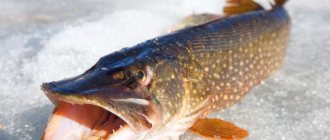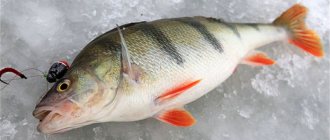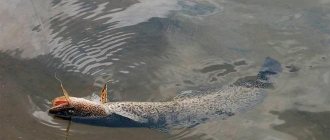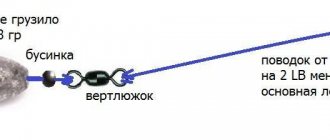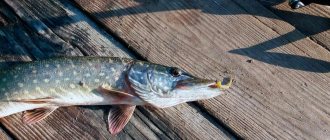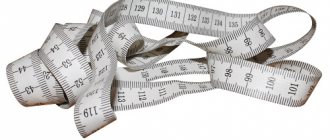"Our Newspaper" begins a series of stories from experienced fishermen, which will become your guide to Crimea
“Our Newspaper” begins a series of stories from experienced fishermen, which will become your guide to Crimea. So, this is my first long night outing on a boat in search of fish.
The impression from him is twofold, of course there were more hopes than were realized in practice, but there is something to strive for.
Such an event needs to be taken seriously and prepared in advance, which we, naturally, did not do.
Packing and waiting for the captain
The most difficult task is to gather everyone on time, because there are always many “buts” and all sorts of force majeure. Fortunately, this time we got ready quite quickly; the boat was already chartered. At 18.00 we stood on the pier waiting for our captain. By the way, this was the first time in my experience that he arrived later than the passengers.
After all the preparatory operations, our longboat called “Sinbad” is already cutting through the waves on the way to the exit from Streletskaya Bay, and our path lies to the Kherson lighthouse, the westernmost point of the Crimean Peninsula - on its spit, because changes in depth are always an interesting place for anyone fisherman
Bluefish fishing: what kind of fish is it and what gear to use when catching it
Bluefish fish will not leave any fisherman indifferent.
Thanks to its biological characteristics, catching underwater inhabitants turns into a real adventure. Knowing the nature and preferences of the bloodthirsty predator, catching bluefish will not be difficult even for novice fishermen. Bluefish fish belongs to the species of ray-finned fish, to the order Perciformes. The fish can reach very large sizes - up to 140 cm in length, weighing about 15 kg. Not everyone will be able to catch such a fish. After all, most often individuals of standard sizes 40 - 50 cm with a body weight of up to 3 kg are caught on the hook. The body of the bluefish is slightly compressed from the sides, covered with round scales. There are two dorsal fins, which are separated by a small gap. The mouth is studded with a large number of sharp teeth, the jaw is large.
The predator usually lives in the Black Sea and is often found in the Sea of Azov and the Kerch Strait. When migrating, fish cover long distances and enter river mouths. The predator is a schooling fish, and they move in huge schools of more than 200 fish. Fish usually live near the surface of the water. Bluefish swim very quickly and develop great speed, especially when it comes to chasing fry.
Active predators purposefully attack their prey, performing various tricks and even jumping out of the water. Carried away by the process, the predator often finds itself on a sloping bank. Before pouncing on the prey, the bluefish, with its head held high, inflates its gills and sharply grabs the prey. After which he instantly swallows the food and returns to the flock.
Bluefish feeding
Since fish are predators, they usually feed on smaller fish. Local fishermen call the fish “Black Sea wolf”, this is due to some features of their behavior. In some cases, a representative of ray-finned fish grabs the victim and tears out several pieces of meat from it, after which it switches to another fish.
Because of this behavior, many believe that the goal of the bluefish is not to eat food, but to destroy the young. The fish is very voracious and bloodthirsty. Their prey can be any fish that they meet along the way. Usually the victims are horse mackerel, herring and even mackerel. However, this factor of aggression is absolutely safe for humans. When a human silhouette appears in the water, a flock of predators quickly takes off on the run.
To get a big catch of bluefish, you need to understand their behavior in different seasons and weather conditions. Let's take a closer look.
Alushta is one of the most fishing regions of the Crimean Peninsula. There is even a village nearby called Rybachye, which is also the best place for fishing in Crimea. In Alushta, a holiday here in any case means going out to sea for sea fishing, or at least catching fish from the shore. Also not far from Alushta there is a small lake where you can go for a picnic and go fishing for freshwater fish.
Bluefish are rarely larger than 40 - 50 cm
Today we’ll talk about fishing for bluefish, which lives in the Black Sea and is found in the Kerch Strait and the adjacent southern territory of the Azov Sea. This fish tries to stay in schools close to the shore, where there are constant local currents and where there is a concentration of small fish.
Relatively small in size (average weight 2-2.5 kg, with a length of 40-50 cm), the bluefish is a fairly insatiable predator, eating mainly small fish. Bluefish persistently pursue schools of small fish like horse mackerel, silverside fish, and anchovy. The main fishing season for bluefish with a spinning rod begins when small fish swim closer to the shore - in mid-summer and almost until the end of autumn.
It also happens: DIY fish baits
To fish for bluefish, you need a two-handed spinning rod with an inertial reel. The fishing line should have a diameter of 0.4 - 0.5 mm. From inertia-free coils, “Dolphin” or “Dolphin-8” coils may be suitable. You need to choose oscillating, elongated spoons, for example: “sports” or “wonderful”, in which the concave parts (at the leash) are filled with molten tin, having previously tinned them.
Fishermen from Alushta successfully catch bluefish using homemade stainless steel spoons, the length of which is 10-12 cm, thickness approximately 5 mm, and width 1-1.2 cm at the head (at the leash), and 0.5-0.6 cm at tail, tee, use No. 10 - 12. Bluefish rarely come close to the shores, only immediately after the end of the storm, so they fish for them mainly from a boat. In the vast expanses of the sea, it is problematic to find bluefish; it is also useless to cast a spinning rod at random - this will only alert the fish.
The surest way to spot bluefish concentrations is to watch the sea surface. Bluefish, like freshwater perches, hunt in a school: as if on command, crashing into the middle of a school of small fish, bluefish push some of the fish to the surface, actively pursuing victims, greedily eating the poor creatures. The attack of bluefish is accompanied by quite noisy splashes. Mandatory participants in bluefish attacks are seagulls: from the behavior of these birds, from afar you can guess the place of the bluefish feast.
What better way to spend your time than this?
Seeing such a sight, immediately swim up to this place, cast the bait into the middle of the stormy sea with a long cast and, without letting it sink too deep, reel in the line at a pace of approximately 1.5-2 revolutions per second. The bluefish bite sharply, like a freshwater asp. A hooked bluefish immediately goes into the depths, then rises to the surface, emerges from the water and rushes to the side.
Often during these manipulations, the bluefish breaks off the hook, so after the first jerk, you need to immediately hook so that the fish does not fall off. We put the reel drum on the brake and fish out. Be prepared for active resistance, the bluefish desperately resists, much more energetically than its freshwater counterparts of the same size.
Waste paper is various types of paper and cardboard products that have served their useful life. Simply put, this is paper waste.
Recycling waste paper is not only a fairly profitable business, but also protects the environment. Companies that accept waste paper pay very good money for it, the price per ton of waste paper is simply amazing, so handing over waste paper is beneficial for any resident of Russia who has a large amount of unnecessary paper or cardboard products accumulated at home.
The use of waste paper as a raw material for production can significantly reduce deforestation. It should be added that you can recycle waste paper 5-7 times, until then its fibers become completely unsuitable for paper production.
Midnight Experiments
Around midnight, my soul begins to demand experiments, and I assemble an ultralight Black Hole Rimer up to 7 grams, equip it with a Tict M-caro mini 5.0g bombard on the leash, and put a TICT VR Hook with a curved hook on the leash (I’ll say in advance that the hooks showed themselves to be excellent , the fish are cut perfectly, both horse mackerel and weasel (due to prying, the number of idle bites has sharply decreased).
I clamp a 0.25 gram shot on the shank of the hook and hang rubber from Maria Dart's (carrot color) and during the night I slowly catch horse mackerel of different calibers, periodically changing the color and shape of the bait.
Sometimes I put the ultralight aside and pick up the Nautilus Black Getter light stick up to 15.5 grams. On it I alternate jigs and bottom rigs.
During the night, I had a small croaker fly into a pink paverizom and a stone crab, which stubbornly refused to let go of my hook, clamped in its claw, even after being lifted on board.
In the dark, the guys took a couple of cuckoos (rock perch). I also caught a large amount of horse mackerel, and periodically at night I pecked at a good weasel.
What did our captain catch?
The captain of the tyrant (specific sea tackle. Its basis is a cord or fishing line) took a couple of good croakers and systematically caught large horse mackerel. The pendants were bitten off by bluefish several times, but were never caught.
A bunch of marine life in the form of some worms and plankton gathered around the boat for illumination, which were actively supported by a predator from below, the echo sounder was just drawing a fish soup under us all night! A garfish periodically circled around the boat, revealing itself with splashes!
How to catch bluefish?
Bluefish is an amazing fish, sometimes called the Black Sea piranha. This is a pronounced predator, voracious and insatiable. Usually it accumulates in schools and stays in coastal waters, where there are constant currents and where there is a lot of small fish.
It also happens: How to catch sharks
On average, the weight of a bluefish that catches a fisherman’s hook can vary from 2 to 4 kg, and its length is 40-60 cm. This voracious predator is always persistent in pursuing smaller fish, and schools of anchovy, mackerel, silverside and other small fish become its prey fish. The bluefish fishing season begins when schools of various small fish approach the shore.
To catch this fish you will need a two-handed spinning rod equipped with an inertial reel “Kyiv”, “Nevskaya” “KS300”, you can also use an inertia-free reel of the “Dolphin” type. The fishing line used for the equipment should have a cross-section of 0.4-0.5 mm. Of the baits, it is most practical to use spinners with an elongated shape such as “wonderful” or “sports”, the concave part of which is usually filled with tin. A bait weighted in this way is more attractive for bluefish due to its performance. It also becomes unnecessary to attach an additional sinker.
Sea fishing for bluefish using homemade stainless steel spoons 12-15 mm wide, about 5 mm thick and 100-120 mm long is also very effective. The bait is equipped with a tee No. 10-12.
Bluefish rarely come close to the shore. This usually happens only after a storm, and because of this, bluefish fishing is usually done from a boat. In the wide expanses of the sea it is quite difficult to spot this fish. It is also completely fruitless to fish the sea with a spinning rod at random, since a lonely shining bait can only alert the bluefish.
The surest way to find bluefish is by observing the water surface. Just like the perch of freshwater reservoirs, this fish hunts in schools and, as if on command, rushes into the very center of a school of small fish. The bluefish pushes part of the small fish to the surface and greedily devours it there. The noisy splashes of the bluefish immediately reveal the location of the “fight.” Where such a fight takes place, seagulls always appear and this is another sign by which bluefish can be identified.
If you manage to find such a place, then bluefish fishing will definitely be successful. With a long cast, send the bait straight into the middle of such a cauldron, but do not let it dive too deep. Wind the line at intervals of 1-2 turns per second. The grip of this predator is as sure and sharp as that of the famous asp.
In this regard, after the first sharp bite of a bluefish, you should immediately hook it so that the hook is firmly stuck into the bony mouth of the predator, then put the reel on the brake and start fishing. Fishing this fish is a real pleasure.
One of the best places on the Black Sea coast for bluefish fishing is Alushta. This is perhaps the most fishy region of the Crimean Peninsula. It is off the coast of Alushta that fishing for bluefish is the most catchy.
A little about the habits and character of the bluefish. As mentioned earlier, this is a schooling predatory fish that collectively hunts for anchovy, horse mackerel, sardines and other small fish. The bluefish attacks fiercely and harshly. He even tears his prey into pieces, even when he is completely satiated. In this case, he eats a small share of his prey, and the rest goes to smaller marine inhabitants.
Bluefish breed in the water column, since this predator comes close to the shore only in the summer. Basically, bluefish become prey for fishermen only when hunting for schools of small fish, when a “bluffar fight” occurs. But sometimes the bluefish comes close enough to the shore and then the fishermen cast their gear directly from the piers and moorings, to the maximum possible distance. It is at such moments that bluefish fishing from the shore is very promising.
But such situations arise quite rarely, and it is mainly caught using watercraft at a depth of about 100 m, and even more.
It also happens: Catching toothy sharks white, tiger, fox, hammerhead with different gear photo video
Bluefish can be used to prepare excellent dishes. Bluefish has very tasty meat. It can be fried, cooked under a weak marinade, stewed with vegetables and spices, smoked, or made into canned food.
Bluefish fishing is very popular in all countries located on the Mediterranean and Black Sea. The best places in Russia where bluefish are caught are the coast of Crimea, the Kerch Strait and the coast of Sochi.
In the morning we decided to change tactics a little
In general, until 5 am the fishing was so-so, let’s say, standard. At 5 o'clock we decide to change the point and go under the radar, and this is where the fun begins! Each cast of the jig yields excellent horse mackerel 25+, but, unfortunately, its release is short-lived, only about 15 minutes. But during this time, emotions overshadowed the whole night!
On one of the casts I feel a blow, and my twitch light bends in a good arc, I feel how the fish begins to sharply lead to the side, I think, well, here it is a sawmill, I scream as I jump, and start pumping out a little bit. The fish butts, but behaves somehow unusually. Imagine my disappointment when I brought a 32 cm long horse mackerel, crimson behind its back, to the side of the boat. I think everyone has had that moment when even a small crimson horse mackerel behaves like a good trophy.
Predator baits
- Pilkers. In sea fishing, a bait called “jig” or “pilker”, whichever is more convenient, is very popular. The most effective model for catching bluefish is a model that has a narrow cast shape. This is due to the fact that there is a slight bend near the tail of the bait, which in turn gives the bait a natural action. The jig is also used for catching fish in fresh water.
Photo 2. Jig - bait for fishing from a boat.
Photo 3. Spoons for sea fish.
To ensure active bluefish fishing, try to fish early in the morning or late in the evening. In addition to exciting fishing, the underwater inhabitant is popular due to its taste qualities, which cannot be compared with other sea fish.
A bloodthirsty predator from the order Perciformes. Bluefish fishing is one of the most interesting from a sporting point of view, thanks to the unstoppable nature of this type of fish.
When catching up with its own prey, it is able to jump out of the water and even onto coastal rocks. This gave rise to many myths and opinions about this predator.
As ferocious as he is in the hunt, he becomes so desperate when he himself acts as the prey, and creates a difficult task for the fisherman.
Brief contents of the review:
conclusions
In general, as I wrote earlier, the impression is twofold. It will be necessary to work on mistakes in order to be prepared for new surprises next time.
For baits, the jig and cicada from the French company Sebile performed well, my already favorite jig from Moncross, and the glowing jig from Higashi for night mackerel.
In terms of tires, the favorites were Marukyu Power Isome in pink, Maria in light accumulative versions and Fina (Hayabusa) in glass color.
Among the mistakes, I would like to highlight the attachment to one point, I think, in a couple of hours of fan casting, we removed all the active ruffs and croakers from the points, and we had to stand in the drift, since the weather allowed.
All of the listed baits and rods can be purchased at the Fisherman’s Store, Sevastopol, st. Mayakovskogo 8 (GUM 2nd floor).
Author: Valera Vred




